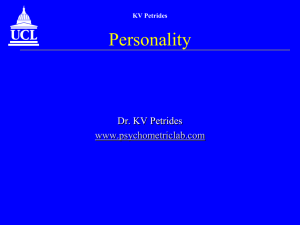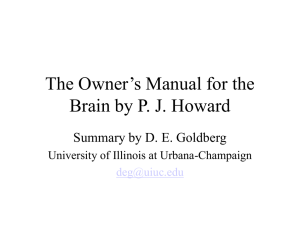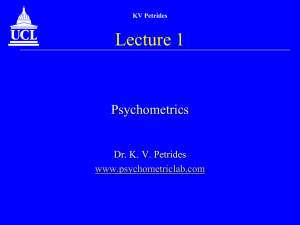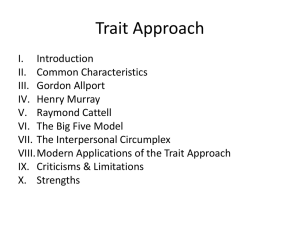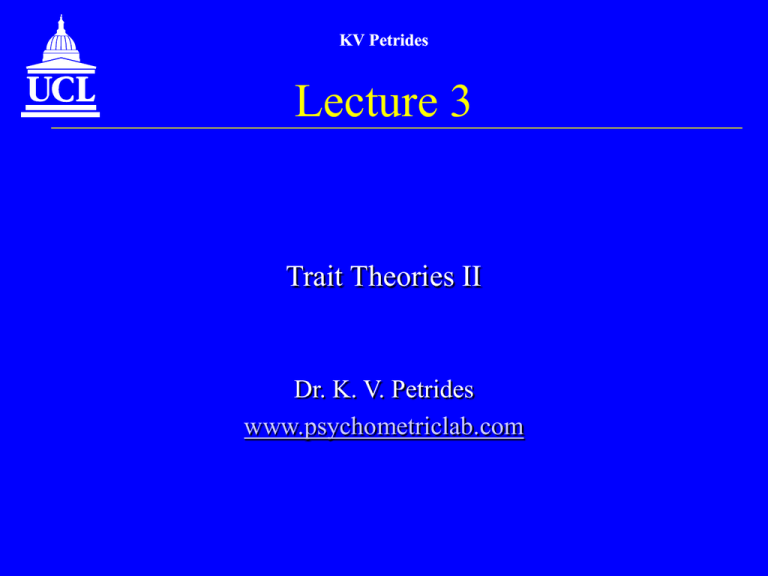
KV Petrides
Lecture 3
Trait Theories II
Dr. K. V. Petrides
www.psychometriclab.com
KV Petrides
Trait theories of personality
• The trait approach to personality is undoubtedly
the dominant approach in the field. Some major
advantages of trait theories:
– Predicated on a vast body of empirical evidence.
– Explicit, testable, and subject to falsification.
– Results and observations are replicable.
• While there is little doubt as regards the relative
advantages of the trait approach, the question of
whose trait theory is best has led to ferocious
battles between some of the greatest psychologists
of all time.
KV Petrides
“Raymond Cattell has been one of the most
influential and original psychologists working in the
field of individual differences in intelligence and
personality, in psychometrics and in behaviour
genetics, and his voluminous writings have been
crucial in the development of a scientific
psychology. Many of his discoveries have become
universal property, such as the distinction between
fluid and crystallized ability, or the state-trait
dichotomy. Few people can have a better claim for
recognition by virtue of the rigor and originality of
the work done.”
- Hans J Eysenck (written shortly before their death)
“When he died, he was the most cited
living psychologist and he is the third
most cited psychologist of all time (after
Sigmund Freud and Jean Piaget). In
this writer’s opinion, Hans Eysenck was
the single most important psychologist
who ever lived. His citation legacy will
be tracked for decades to come.”
– J Philippe Rushton (2001, Personality
and Individual Differences, 31, 17-39).
KV Petrides
Eysenck’s theory of personality I
• To summarize 1000+ journal articles and 80 books:
• Eysenckian theory developed considerably after Eysenck’s
(1947) seminal book Dimensions of Personality.
• His initial theory proposed two basic personality
dimensions, viz., Extraversion versus Introversion and
Neuroticism versus Stability.
• Extraversion is characterized by adjectives like ‘sociable’
and ‘active,’ whereas the opposite pole (introversion) is
characterized by adjectives like ‘quiet’ and ‘passive’.
• Neuroticism is characterized by adjectives like ‘moody’
and ‘touchy,’ whereas the opposite pole (stability) is
characterized by adjectives like ‘calm’ and ‘relaxed’.
Moody
KV Petrides
UNSTABLE
Touchy
Anxious
Restless
Rigid
Aggressive
Sober
Excitable
Pessimistic
Changeable
Reserved
Impulsive
Unsociable
Optimistic
Quiet
Active
Melancholic Choleric
INTROVERTED
Passive
Phlegmatic
Sanguine
EXTROVERTED
Sociable
Careful
Outgoing
Thoughtful
Talkative
Peaceful
Responsive
Controlled
Easygoing
Reliable
Lively
Even-tempered
Calm
Carefree
Leadership
STABLE
KV Petrides
Eysenck’s theory of personality II
• Eysenck (1976) added a third major dimension to the
taxonomy, viz., Psychoticism versus Normality. This
was the second psychopathological dimension in the
system, incorporated because the two existing
dimensions could not distinguish between borderline
schizophrenics and controls.
• Psychoticism is characterized by adjectives like
‘emotionally cold’ and ‘nonconformist,’ whereas the
opposite pole (normality) is characterized by
adjectives like ‘warm’ and ‘empathic’.
• There is considerable empirical evidence
underpinning the Eysenckian factors (especially E and
N).
KV Petrides
KV Petrides
Introversion versus Extraversion - Theory
• Eysenck hypothesized that the biological basis of
Extraversion lies in individual differences in cortical
arousal.
• Introverts tend to have a chronically over-aroused
central nervous system (CNS; brain and spinal cord),
whereas extraverts tend to have a chronically underaroused CNS.
• Introverts are less susceptible to reactive inhibition
(Hull’s concept of neural fatigue building from
repeated exposure to the same stimulus or action).
KV Petrides
Introversion versus Extraversion - Evidence
• Introverts versus Extraverts:
– Over- versus under-responsive central nervous system
• Evidence: introverts less likely to use alcohol, cigarettes,
drugs.
– Strong versus weak excitatory processes.
• Evidence: Introverts have lower pain tolerance.
– More versus less cortical arousal.
• Evidence: Introverts better able to tolerate sensory deprivation.
– Brains react more versus less quickly and strongly
(brain reactivity hypothesis).
• Evidence: Introverts are easier to condition (but not always).
– Less versus more susceptible to reactive inhibition.
• Evidence: Introverts tend to persist at activities longer.
KV Petrides
Neuroticism versus Stability
• Eysenck hypothesized that the biological basis of
Neuroticism lies in individual differences in the lability of
the autonomic nervous system (ANS).
• The ANS is part of the peripheral nervous system and
consists mainly of sensory and motor neurons. It is
responsible for monitoring conditions in the internal
environment and bringing about appropriate changes in
them.
• Neurotics tend to have a more labile (unstable, readily
open to change, rapidly adjustable) ANS than their stable
peers.
• While the theoretical predictions are relatively clear and
specific, corroborating evidence from psychophysiological
studies of N has not been forthcoming.
KV Petrides
E and N as emotionality
• As noted in Lecture 2, E and N have also been conceptualized as positive and
negative emotionality respectively.
N
Canli et al., 2001
E
KV Petrides
Psychoticism versus normality
• In many ways (e.g., theoretical, psychometric,
empirical), Psychoticism is the weakest of the
Eysenckian dimensions.
• Eysenck did not develop a clear theory about the
biological basis of Psychoticism.
• There is robust evidence linking Psychoticism to
maleness:
– Males score higher than females on P scales.
– Criminals and schizophrenics score higher on P and are
overwhelmingly male.
• Based on such evidence, Eysenck postulated that
Psychoticism is linked to male hormonal levels
(androgens).
KV Petrides
Eysenck’s personality measures
•
The development of the inventories used to operationalize the Eysenckian
dimensions has mirrored the development of the underlying theory.
KV Petrides
Eysenck’s theory of personality III
• Psychometric properties
– Excellent factor structure.
– Good reliabilities (P somewhat problematic).
• Heritability indices
R Plomin
– High heritability indices confer psychological significance on
variables, thus countering objections that they might be statistical
artifacts.
– Eaves, Martin, and Eysenck (1989) suggested that up to about 70%
of the population variance is attributed to genetic factors. The
work of R Plomin is especially relevant and important here.
• Physiological evidence
– There has been moderate success with E and, less so, with N (see,
e.g., Canli et al., 2001; Matthews & Gilliland, 1999). Eysenckian
P remains under-researched. J A Gray’s theory a powerful
competitor here.
KV Petrides
E’s theory – Cross-cultural data I
• Barrett, Petrides, Eysenck, and Eysenck (1998)
conclusively demonstrated the replicability of the
three Eysenckian superfactors with data from 34
different countries.
• High congruences for the Giant 3 as well as for the
L(ie) scale.
• More variable congruences for P and L than for E and
N.
• Results demonstrate that even though specific items
may be lost across cultures (especially in the case of
P), the core factors remain identifiable and
mathematically discriminable.
Barrett et al. (1998)
KV Petrides
E’s theory – Cross-cultural data II
Male data
Female data
KV Petrides
E’s theory – External correlates
• Below are some ‘real-life’ criteria that have been
found to correlate reliably with the Eysenckian
dimensions:
– Extraversion
• Sporting behaviour, early onset of sexual behaviour, tobacco
and alcohol consumption, hedonism, accident proneness.
– Neuroticism
• Unsatisfactory sex life, stress symptoms, cancer (-), gaze
aversion, likelihood of divorce (mainly in females).
– Psychoticism
• Instrumental aggression (e.g., robbery, burglary), car theft,
pornography consumption, permissive attitudes towards sex.
KV Petrides
Gray’s theory of personality I
• Jeffrey Gray proposed a modification of Eysenck’s
model leading to a theory that is more firmly
rooted in psychophysiological mechanisms.
• Gray postulated that the brain has separate reward
and punishment systems, which are important in
the development of personality.
• This hypothesis was originally predicated on
animal learning and physiological research.
• Most empirical support for this theory has been
obtained through animal research.
KV Petrides
Gray’s theory of personality II
• Gray proposed a 45° (later amended to 30°) rotation of
the Eysenckian dimensions of Extraversion and
Neuroticism.
• This rotation resulted in two alternative dimensions to
describe the same factor space.
– Anxiety, which concerns individual differences in sensitivity
to punishment. This dimension runs from stable
extraversion, at the low end, to neurotic introversion, at the
high end.
– Impulsivity, which concerns individual differences in
sensitivity to reward. This dimension runs from stable
introversion, at the low end, to neurotic extraversion, at the
high end.
KV Petrides
Gray’s theory of personality III
KV Petrides
BAS/BIS I
• Anxiety and impulsivity are associated with the two
brain systems that control sensitivity to reward (BAS)
and punishment (BIS), respectively.
• The Behavioural Activation System (BAS) is related to
sensitivity and motivation to seek potential rewards
(e.g., sexual drive). It is also known as the ‘GO’
system.
• The Behavioural Inhibition System (BIS) is related to
sensitivity and motivation to avoid punishment (e.g.,
aggression). It is also known as the ‘avoidance
motivation’ or ‘STOP’ system.
KV Petrides
BAS/BIS II
• Correlates and characteristics of BAS:
– reward-seeking
– experiencing positive emotions and anticipating good
events
– impulsivity
– depression (under-sensitive BAS)
• Correlates and characteristics of BIS:
–
–
–
–
responsive to cues of punishment or danger
inhibits movement towards goals
anxiety
depression
KV Petrides
BAS/BIS, arousal, and E & N
• BAS and BIS are mutually inhibitory.
• Both BAS (produces energy) and BIS (produces tension) influence the
arousal system.
• Extraversion relates primarily to BAS (30°).
• Neuroticism relates primarily to BIS (30°).
KV Petrides
Gray’s theory - Evidence
• Support for Gray’s theory has been scarce and inconsistent.
• There is impressive evidence from animal studies
supporting BIS-based explanations of the effects of
anxiolytic drugs.
• However, these results do not seem to be replicable in
human samples. It is likely that human anxiety is much
more amenable to cognitive control (self-regulatory
processes) than animal anxiety.
• The psychometrics of the theory are problematic both in
terms of the operationalization of the BIS/BAS and in
terms of their interrelationship.
– If BIS/BAS are mutually inhibitory, is it sensible to think of
anxiety and impulsivity as orthogonal?
KV Petrides
On the web
• http://www.personality-project.org/
– Maintained by W. Revelle
• http://freespace.virgin.net/darrin.evans/
– The H J Eysenck official web page
• http://www.cattell.net/devon/rbcmain.htm
– The R B Cattell memorial page
• http://www.spsp.org/
– Society for Personality and Social Psychology

